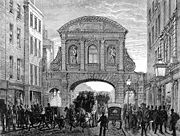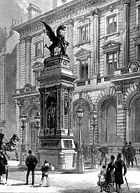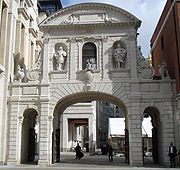
Temple Bar, London
Encyclopedia





City of London
The City of London is a small area within Greater London, England. It is the historic core of London around which the modern conurbation grew and has held city status since time immemorial. The City’s boundaries have remained almost unchanged since the Middle Ages, and it is now only a tiny part of...
on the road to Westminster
City of Westminster
The City of Westminster is a London borough occupying much of the central area of London, England, including most of the West End. It is located to the west of and adjoining the ancient City of London, directly to the east of the Royal Borough of Kensington and Chelsea, and its southern boundary...
, where Fleet Street
Fleet Street
Fleet Street is a street in central London, United Kingdom, named after the River Fleet, a stream that now flows underground. It was the home of the British press until the 1980s...
(extending westwards) becomes the Strand
Strand, London
Strand is a street in the City of Westminster, London, England. The street is just over three-quarters of a mile long. It currently starts at Trafalgar Square and runs east to join Fleet Street at Temple Bar, which marks the boundary of the City of London at this point, though its historical length...
. Until 1878, this boundary was demarcated by a stone gateway designed by Christopher Wren
Christopher Wren
Sir Christopher Wren FRS is one of the most highly acclaimed English architects in history.He used to be accorded responsibility for rebuilding 51 churches in the City of London after the Great Fire in 1666, including his masterpiece, St. Paul's Cathedral, on Ludgate Hill, completed in 1710...
.
In the Middle Ages
Middle Ages
The Middle Ages is a periodization of European history from the 5th century to the 15th century. The Middle Ages follows the fall of the Western Roman Empire in 476 and precedes the Early Modern Era. It is the middle period of a three-period division of Western history: Classic, Medieval and Modern...
, the authority of the City of London Corporation reached beyond the city's ancient walls in several places (the Liberties of London); to regulate trade into the city, barriers were erected on the major roads wherever the true boundary was a substantial distance from the old gatehouse. Temple Bar was the most famous of these, since traffic between London (England's prime commercial centre) and Westminster (the political centre) passed through it. Its name comes from the Temple Church
Temple Church
The Temple Church is a late-12th-century church in London located between Fleet Street and the River Thames, built for and by the Knights Templar as their English headquarters. In modern times, two Inns of Court both use the church. It is famous for its effigy tombs and for being a round church...
, which has given its name to a wider area south of Fleet Street, the Temple, once belonging to the Knights Templar
Knights Templar
The Poor Fellow-Soldiers of Christ and of the Temple of Solomon , commonly known as the Knights Templar, the Order of the Temple or simply as Templars, were among the most famous of the Western Christian military orders...
, but now home to two of the legal profession's Inns of Court
Inns of Court
The Inns of Court in London are the professional associations for barristers in England and Wales. All such barristers must belong to one such association. They have supervisory and disciplinary functions over their members. The Inns also provide libraries, dining facilities and professional...
), which is located nearby.
It has long been the custom that the monarch
British monarchy
The monarchy of the United Kingdom is the constitutional monarchy of the United Kingdom and its overseas territories. The present monarch, Queen Elizabeth II, has reigned since 6 February 1952. She and her immediate family undertake various official, ceremonial and representational duties...
stop at Temple Bar before entering the City of London, so that the Lord Mayor may offer him or her the City's pearl-encrusted Sword of State
Sword of State
A sword of state is a sword, used as part of the regalia, symbolizing the power of a monarch to use the might of the state against its enemies, and their duty to preserve thus right and peace.It is known to be used in following monarchies:...
as a token of loyalty. This historic ceremony has often featured in art and literature, as well as shown on television when it occurs at special occasions in the present era. However, the popular view that the monarch requires the Lord Mayor's permission to enter the City is incorrect.
Today Temple Bar (like other major entrances to the City of London) is marked by a stone monument in the middle of the roadway, topped by a statue of a griffin
Griffin
The griffin, griffon, or gryphon is a legendary creature with the body of a lion and the head and wings of an eagle...
, a winged lion with the head of an eagle; a pair of dragons are more properly supporters of the City's arms
Coat of arms
A coat of arms is a unique heraldic design on a shield or escutcheon or on a surcoat or tabard used to cover and protect armour and to identify the wearer. Thus the term is often stated as "coat-armour", because it was anciently displayed on the front of a coat of cloth...
.
The structure
The earliest Temple Bar may have been no more than a turnpikeTurnpike trust
Turnpike trusts in the United Kingdom were bodies set up by individual Acts of Parliament, with powers to collect road tolls for maintaining the principal highways in Britain from the 17th but especially during the 18th and 19th centuries...
; there was a gate of some kind from 1293. One was badly damaged during the Peasants' Revolt
Peasants' Revolt
The Peasants' Revolt, Wat Tyler's Rebellion, or the Great Rising of 1381 was one of a number of popular revolts in late medieval Europe and is a major event in the history of England. Tyler's Rebellion was not only the most extreme and widespread insurrection in English history but also the...
in 1381.
By the late Middle Ages
Middle Ages
The Middle Ages is a periodization of European history from the 5th century to the 15th century. The Middle Ages follows the fall of the Western Roman Empire in 476 and precedes the Early Modern Era. It is the middle period of a three-period division of Western history: Classic, Medieval and Modern...
a wooden archway (with a prison above) stood on the spot. Although it escaped damage by the Great Fire of London
Great Fire of London
The Great Fire of London was a major conflagration that swept through the central parts of the English city of London, from Sunday, 2 September to Wednesday, 5 September 1666. The fire gutted the medieval City of London inside the old Roman City Wall...
, it was decided as part of the improvements undertaken by the City to rebuild the structure. Commissioned by King Charles II
Charles II of England
Charles II was monarch of the three kingdoms of England, Scotland, and Ireland.Charles II's father, King Charles I, was executed at Whitehall on 30 January 1649, at the climax of the English Civil War...
, and designed by Sir Christopher Wren
Christopher Wren
Sir Christopher Wren FRS is one of the most highly acclaimed English architects in history.He used to be accorded responsibility for rebuilding 51 churches in the City of London after the Great Fire in 1666, including his masterpiece, St. Paul's Cathedral, on Ludgate Hill, completed in 1710...
, the fine arch of Portland stone
Portland stone
Portland stone is a limestone from the Tithonian stage of the Jurassic period quarried on the Isle of Portland, Dorset. The quarries consist of beds of white-grey limestone separated by chert beds. It has been used extensively as a building stone throughout the British Isles, notably in major...
was constructed between 1669 and 1672. During the 18th century, the heads of traitors were mounted on pikes and exhibited on the roof.
The other seven principal gateways to London (Ludgate
Ludgate
Ludgate was the westernmost gate in London Wall. The name survives in Ludgate Hill, an eastward continuation of Fleet Street, and Ludgate Circus.-Etymology:...
, Newgate
Newgate
Newgate at the west end of Newgate Street was one of the historic seven gates of London Wall round the City of London and one of the six which date back to Roman times. From it a Roman road led west to Silchester...
, Aldersgate
Aldersgate
Aldersgate was a gate in the London Wall in the City of London, which has given its name to a ward and Aldersgate Street, a road leading north from the site of the gate, towards Clerkenwell in the London Borough of Islington.-History:...
, Cripplegate
Cripplegate
Cripplegate was a city gate in the London Wall and a name for the region of the City of London outside the gate. The area was almost entirely destroyed by bombing in World War II and today is the site of the Barbican Estate and Barbican Centre...
, Moorgate
Moorgate
Moorgate was a postern in the London Wall originally built by the Romans. It was turned into a gate in the 15th century. Though the gate was demolished in 1762, the name survives as a major street in the City of London...
, Bishopsgate
Bishopsgate
Bishopsgate is a road and ward in the northeast part of the City of London, extending north from Gracechurch Street to Norton Folgate. It is named after one of the original seven gates in London Wall...
and Aldgate
Aldgate
Aldgate was the eastern most gateway through London Wall leading from the City of London to Whitechapel and the east end of London. Aldgate gives its name to a ward of the City...
) had all been demolished by 1800, but Temple Bar remained as an impediment to the ever-growing traffic. It was discovered that the keystones
Keystone (architecture)
A keystone is the wedge-shaped stone piece at the apex of a masonry vault or arch, which is the final piece placed during construction and locks all the stones into position, allowing the arch to bear weight. This makes a keystone very important structurally...
had dropped in 1874. In 1878 the City of London Corporation, eager to widen the road but unwilling to destroy so historic a monument, dismantled it piece-by-piece over an 11-day period and stored its 2,700 stones carefully.
In 1880, the brewer Sir Henry Meux
Henry Meux
Sir Henry Meux, 2nd Baronet , was head of Meuxand Co., a London brewery, and a Member of Parliament .His name is pronounced "myooks", and he succeeded to his father's baronetcy on 30 September 1831. He married Lady Louisa Caroline Brudenell-Bruce on 19 January 1856.He served as High Sheriff of...
bought the stones (at the instigation of his wife, Valerie Susan Meux, a barmaid he married amid much scandal) and re-erected the arch as a gateway at his house, Theobalds Park
Theobalds House
Theobalds House , located in Theobalds Park, just outside Cheshunt in the English county of Hertfordshire, was a prominent stately home and royal palace of the 16th and early 17th centuries.- Early history :...
, between Enfield
London Borough of Enfield
The London Borough of Enfield is the most northerly London borough and forms part of Outer London. It borders the London Boroughs of Barnet, Haringey and Waltham Forest...
and Cheshunt
Cheshunt
Cheshunt is a town in Hertfordshire, England with a population of around 52,000 according to the United Kingdom's 2001 Census. It is a dormitory town and part of the Greater London Urban Area and London commuter belt served by Cheshunt railway station...
in Hertfordshire
Hertfordshire
Hertfordshire is a ceremonial and non-metropolitan county in the East region of England. The county town is Hertford.The county is one of the Home Counties and lies inland, bordered by Greater London , Buckinghamshire , Bedfordshire , Cambridgeshire and...
.
It remained there, incongruously sitting in a clearing in a wood, until 2003. By then it had been purchased by the Temple Bar Trust from the Meux Trust for £1 in 1984. It was carefully dismantled and returned on 500 pallets to the City of London, where it was painstakingly re-erected as an entrance to the Paternoster Square
Paternoster Square
Paternoster Square is an urban development, owned by the Mitsubishi Estate Co., next to St Paul's Cathedral in the City of London, England. In 1942 the area, which takes its name from Paternoster Row, centre of the London publishing trade, was devastated by aerial bombardment in The Blitz during...
redevelopment just north of St Paul's Cathedral
St Paul's Cathedral
St Paul's Cathedral, London, is a Church of England cathedral and seat of the Bishop of London. Its dedication to Paul the Apostle dates back to the original church on this site, founded in AD 604. St Paul's sits at the top of Ludgate Hill, the highest point in the City of London, and is the mother...
. It opened to the public in late 2004.
In fiction
The 'Griffin' on top of Temple Bar comes to life in Charlie FletcherCharlie Fletcher
Charlie Fletcher is a British screenwriter and author.After many years writing for film and television, he is now probably best known for his children's novel, Stoneheart.-Biography:...
's children's book about unLondon, Stoneheart
Stoneheart
Stoneheart is a children's novel by Charlie Fletcher, published in 2006. It is part of the Stoneheart Trilogy. Stoneheart is followed by "Ironhand", which is itself followed by "Silver Tongue"...
.
Charles Dickens
Charles Dickens
Charles John Huffam Dickens was an English novelist, generally considered the greatest of the Victorian period. Dickens enjoyed a wider popularity and fame than had any previous author during his lifetime, and he remains popular, having been responsible for some of English literature's most iconic...
mentioned Temple Bar
Temple Bar
Temple Bar may refer to:* The Temple Bar, a spot in London* Temple Bar, Dublin, a cultural quarter in Dublin city* Temple Bar, Ceredigion, a village in Wales* Temple Bar Magazine, British literary magazine published 1860 to 1906...
in Book II, Chapter I of A Tale of Two Cities
A Tale of Two Cities
A Tale of Two Cities is a novel by Charles Dickens, set in London and Paris before and during the French Revolution. With well over 200 million copies sold, it ranks among the most famous works in the history of fictional literature....
, noting its proximity to Tellson's Bank, also on Fleet Street. This was in fact Child & Co. which used the upper rooms of the Bar as storage space. While critiquing the moral poverty of late-18th century London, Dickens wrote that in matters of crime and punishment, "putting to death was a recipe much in vogue," and illustrated the horror caused by severed heads, "exposed on Temple Bar with an insensate brutality and ferocity..."
In Herman Melville
Herman Melville
Herman Melville was an American novelist, short story writer, essayist, and poet. He is best known for his novel Moby-Dick and the posthumous novella Billy Budd....
's Paradise of Bachelors and Tartarus of Maids
Paradise of Bachelors and Tartarus of Maids
"The Paradise of Bachelors and the Tartarus of Maids" is a short story written by American writer Herman Melville in April 1855. Best known for his novel Moby-Dick, Melville wrote numerous books and short stories...
, Melville contrasts the beauty of the Temple Bar gateway with the highest point on the road leading to the hellish paper factory, which he calls a "Dantean Gateway." (Dante describes the gateway to hell in his Inferno, over which are written the words, "Abandon hope, all ye who enter here.")

